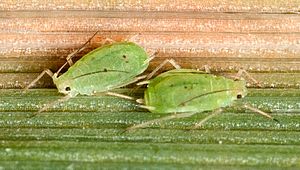Greenbug facts for kids
The greenbug, also known as the wheat aphid (Schizaphis graminum), is a tiny insect. It belongs to a group called aphids. Greenbugs are true bugs that like to eat the leaves of grasses. This includes important crops like wheat and sorghum.
Greenbugs originally came from Europe and Asia (the Palaearctic region). But now, they can be found in many other parts of the world. There are about 40 different types of Schizaphis species around the globe.
Quick facts for kids Greenbug |
|
|---|---|
 |
|
| Scientific classification | |
| Kingdom: | |
| Phylum: | |
| Class: | |
| Order: | |
| Family: |
Aphididae
|
| Genus: |
Schizaphis
|
| Species: |
S. graminum
|
| Binomial name | |
| Schizaphis graminum (Rondani, 1852)
|
|
| Synonyms | |
|
|
Contents
What Does a Greenbug Look Like?
Adult greenbugs are very small, about 1.3 to 2.1 millimeters long. That's less than an inch! Their head and chest area are usually straw-colored or pale green. Their body (abdomen) is a mid-green color.
Younger greenbugs and some adults have a dark green stripe down their back. Their antennae are dark, and their cornicles (small tubes on their back) are pale with dark tips.
Early in the season, most adult greenbugs do not have wings. But if there are too many greenbugs in one place, some will grow wings. These winged greenbugs can then fly to new plants to find more food.
What Plants Do Greenbugs Eat?
Greenbugs almost only eat different kinds of grasses. These grasses belong to the plant family called Poaceae. Some of the plants they attack include:
- Agropyron
- Avena (oats)
- Bromus
- Dactylis
- Eleusine
- Festuca
- Hordeum (barley)
- Lolium
- Oryza (rice)
- Panicum
- Poa
- Sorghum
- Triticum (wheat)
- Zea (corn)
They have also been reported as a problem for pearl millet crops in Pakistan.
Greenbug Life Cycle

In warm places, female greenbugs can have babies all by themselves. This is called parthenogenesis. They don't need a male to reproduce. A female greenbug can produce up to five baby nymphs every day.
It takes about seven to nine days for a greenbug to grow from a nymph to an adult. This happens when the temperature is between 60 and 80 degrees Fahrenheit (15 to 27 degrees Celsius).
In colder places, female greenbugs will mate with winged males in the autumn. The eggs then stay on grasses like Poa pratensis (Kentucky bluegrass) over the winter. In some areas, greenbugs can have up to fifteen generations in one year! The best temperature for greenbugs without wings is around 20 degrees Celsius (68 degrees Fahrenheit). For winged greenbugs, it's about 27 degrees Celsius (81 degrees Fahrenheit).
How Greenbugs Harm Plants
When greenbugs feed, they suck the sap from plant leaves. At first, this causes small yellow or red spots on the leaves. As more greenbugs gather, the plant turns more yellow and red. Eventually, the leaves and roots can die. In very bad cases, the whole plant might die.
On farm crops like wheat, greenbugs can make the plants smaller and reduce how much food they produce. In lawns, the tips of the grass blades turn yellow with brown ends. This looks very different from healthy grass. As the leaves die, the greenbugs move to fresh, healthy parts of the plant.
Greenbugs can also spread plant viruses. They act as a vector (a carrier) for several plant diseases. These include:
- barley yellow dwarf virus
- sugarcane mosaic virus
- maize dwarf mosaic virus
- millet red leaf virus
See also
 In Spanish: Pulgón de los cereales para niños
In Spanish: Pulgón de los cereales para niños

